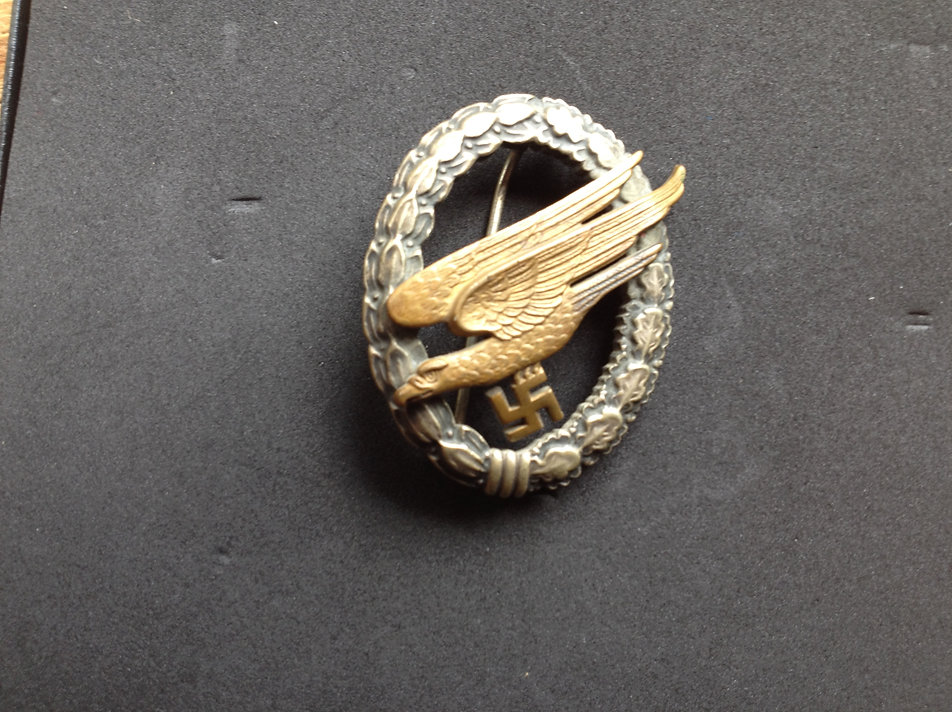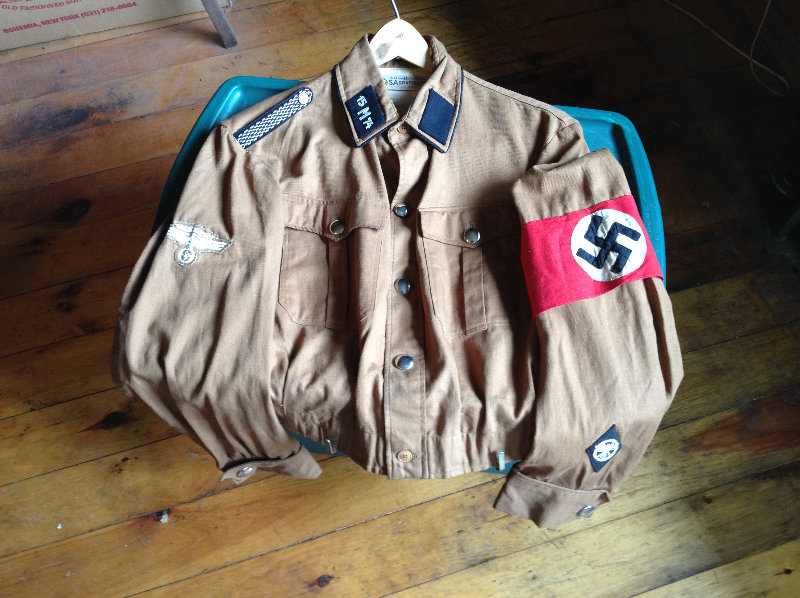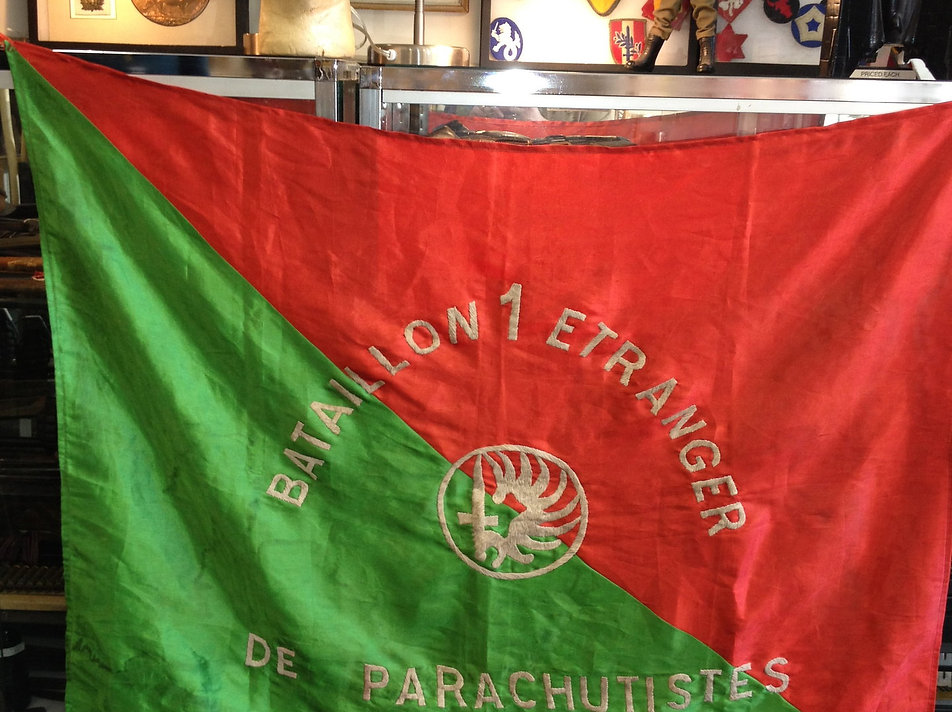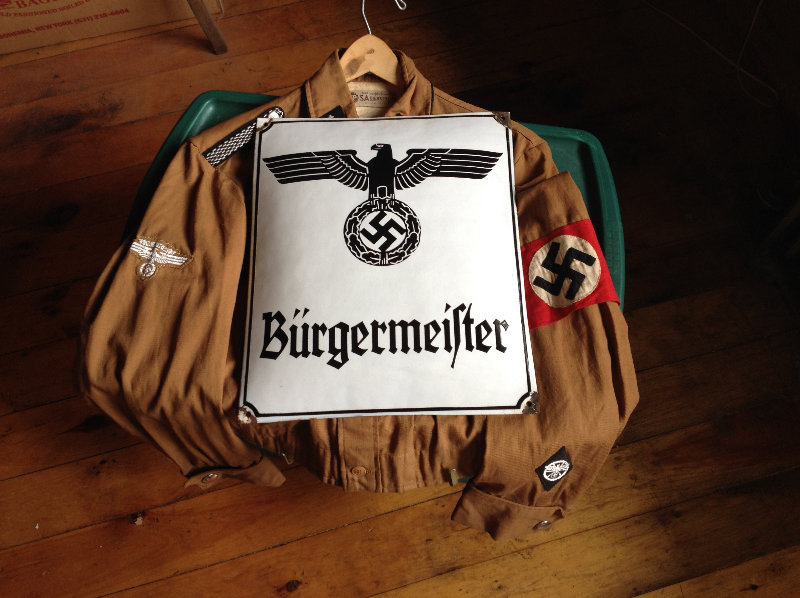Editor’s note: The Museum Files is an ongoing series telling the stories behind artifacts at local museums and institutions.
LAKE GEORGE — Tony Fidd has kept a dark secret hidden in a box for several years.
“Historically, it is very important,” Fidd said as he handled a worn Nazi officer’s jacket, a piece he acquired at an estate auction but has kept tucked away. “I haven’t wanted to glorify it.”
As founder of The Patriot of Lake George, a museum and gift shop dedicated to the remembrance of veterans and service personnel, Fidd focuses on World War II artifacts and memorabilia. The shop, which feels like a trip back in time to the era of war bonds and Rosie the Riveter, celebrates the accomplishments of men and women who fought for their country.
Fidd, a full-time Warren County communications officer, turned his off-duty collecting hobby into a storefront to share his admiration for the courageous “Greatest Generation” with tourists ambling through the village on a balmy summer day. While other merchants offer up seagull figurines and Duck Dynasty T-shirts, Fidd is focused on peddling history one anecdote at a time to anyone willing to listen.
But along with the sagas of heroism and sacrifice are more difficult tales to tell. Bravery and social justice are only half of the story.
The horrors of the Nazi regime are a much more difficult subject to tackle.
Inside the breast pocket of the German uniform, now riddled with moth holes, is a tailor’s label with a name scrawled in script. After purchasing the garment, Fidd searched for information about its original owner, scouring the Internet for references to Nazi officials. He cross-referenced various sources, trying to confirm the horrific details he uncovered.
His efforts led him to the book “Hunting Evil: The Nazi War Criminals who Escaped and the Quest to Bring Them to Justice” by English author Guy Walters. Walters’ extensively researched book chronicles a number of notorious figures, including Dr. Friedrich Buchardt.
Buchardt, who was born in 1909 in Latvia, rose through the ranks during the war, at first classifying prisoners through “racial grading” and ultimately being directly responsible for thousands of people executed at concentration camps.
Fidd is confident the garment he purchased at an auction near Putnam, which dissolved the estate of a deceased World War II veteran, once belonged to a man whose “blood experience” earned him high military honors.
“Although it is impossible to be précise about how many deaths Buchardt’s commando was responsible for, the figure is likely to be in the tens of thousands,” Walters writes in “Hunting Evil.” “The murders won him more distinctions, as Buchardt was awarded a First Class Iron Cross, a First Class War Cross of Merit with Swords, A Silver Badge of Courage and an Infantry Assault Badge in Silver.”
Crimes Unpunished
Walters, a former Times of London reporter, wrote “Hunting Evil,” published in 2009, as a definitive account of how the Nazis escaped and were pursued and captured.
“I thought that up until then, there had been very little serious research into the topic of Nazi Hunting,” Walters said. “Hitherto, it had been very much within the ambit of the writers of schlocky ’70s screenplays and distorted by that old fraud, Simon Wiesenthal.”
Weisenthal, who died in 2005, was a self-proclaimed “Nazi hunter” whose historical work has been faulted by some critics as being partially fictionalized.
While researching his own book, Walters came across information on Buchardt, a lesser-known name integral to operations involving the Baltic states, Poland and Russia.
“I was told about him by Eli Rosenbaum, who at the time was the head of the Office of Special Investigations, the former U.S. agency that seeks out and expels former Nazis from the United States,” Walters said.
Buchardt was stationed at various spots throughout the war. One of his last assignments in 1944 was heading Sonderkommando Ost, a division that gathered intelligence on Russian personnel residing in German territory. Otto Ohlendorf, a German SS-Gruppenführer, named Buchardt to lead the southeastern sector of the network, and he was dispatched from Berlin to Karlsbad. His group was forced to retreat, and he was last seen near Innsbruck.
Buchardt was captured shortly after the war. Fidd surmises the veteran who stored the uniform for years at his upstate New York farm might have been one of the American soldiers who helped secure the fugitive — the jacket a souvenir of the achievement.
Although the Americans handed Buchardt over to the British and he was held at a POW camp in Rimini, Burchardt was never tried for his crimes.
According to Walters, Buchardt furnished a document titled “The Handling of the Russian Problem during the Period of the Nazi Regime in Germany,” a blueprint of his own espionage operations in Eastern Europe. Buchardt’s knowledge impressed the British Secret Intelligence Service, and he collaborated with the agency until 1947. Walters believes it is likely the former Nazi officer, whom he describes as “the most murderous Nazi employed by the Allies after the war,” went to work for the Americans at that point.
The notorious Nazi, directly responsible for the genocide of thousands of Jews, lived a free man for years in Germany. He died in 1982 in Austria.
“Espionage is by its nature a cynical business. The best sources of information are not always the whiter-than-white deputy head boy,” Walters said.
Unsettling history
David G. Marwell is a museum director with a past befitting an HBO drama.
The head of the Museum of Jewish Heritage in New York City, Marwell once served as chief of investigative research for the U.S. Department of Justice Office of Special Investigations. One of his main duties was conducting historical and forensic research in support of the prosecution of Nazi war criminals.
Today, his energy is focused on documenting the stories of Jewish culture — before, during and after the Holocaust.
“We look at how the Jews responded, not what the Nazis did to the Jews,” Marwell said.
For Marwell, World War II-related items, like the Nazi uniform at The Patriot of Lake George, are not intrinsically offensive. Context is an important part of any museum installation.
“Artifacts are very powerful communicators. I always say that a museum, more than any other medium, can communicate to people in a direct way. Being in the presence of an authentic artifact in the right context speaks to something innately human. They call on our imagination and our sense of empathy,” he said.
Although Marwell said he would not display the Nazi jacket in his own museum, he said he could imagine it being right for some institutions.
“It really depends on the museum and what their mission is. In a military museum or a World War II museum, it would be quite appropriate. It helps to tell the story,” he said.
For survivors of the occupation and concentration camps and their families, any Nazi artifact — even in an appropriate historical context — hits too close to home.
Joy Muller-McCoola of Glens Falls grew up in the shadow of the Holocaust. Both of her Polish parents, Oscar and Lily Muller, managed to make it through the war alive, although most of their relatives perished.
Oscar, who died in 2011, was imprisoned at three different concentration camps. He watched as Germans murdered most of his immediate family.
“The old and sick were taken to the outskirts of the city, killed and burned to make room for more,” he wrote in 1942 in his diary. “Women and children were sent to Belzec where elaborate places were built to kill them by pumping gas. This made it possible to kill lots of people quickly.”
Lily, who is 91, grew up in Lodz, a ghetto where Buchardt oversaw violent exterminations. She spent her youth in the Warsaw ghetto and forced labor.
“My mother doesn’t even like to hear German spoken because of the horrid memories she associated with hearing it,” Muller-McCoola said.
For both of her parents, the events of the war were more than distant memories — they became part of their identity.
“Through the years, I have tried to protect my parents from different events and things that might stir up emotions, but there is no protecting them. It was with them every day,” Muller-McCoola said.
She has never been to the Patriot of Lake George — or even heard of it, but Muller-McCoola said the context of her own life prevents her from wanting to see Nazi artifacts.
“I wouldn’t want it put in my face,” she said.
Muller-McCoola, however, doesn’t place judgment on the uniform’s historical value.
“I don’t want other people to be sheltered from it. You don’t wipe out ugly pieces of history. I want people to be reminded of the horrible things that happened,” she said.
Selling out
When Fidd first saw the Nazi jacket, it was among a household of items — everything from furniture to memorabilia — that a veteran had amassed during his lifetime. According to Fidd, another World War II collector got wind of the artifact and showed up for the auction.
The two battled it out.
“He dropped out as it got more expensive,” Fidd said.
World War II items continue to be popular with collectors, but the sale of vintage Nazi items has become controversial in recent years.
“People are fascinated by it, There is a big market in military and Nazi paraphernalia and documents, and I do think it is disturbing,” Marwell said.
For Walters, the Nazi jacket isn’t historically relevant.
“It is of very little significance at all. I suppose there are twisted geeks out there who like collecting SS uniforms, but to do so runs the risk of fetishization and promotion,” he said.
Laws in France, Germany, Italy and Austria block the sale of Nazi items. Internet auction site eBay recently expanded its policy banning the sale of items that promote hate or violence to include historical objects from Nazi Germany, the Ku Klux Klan and notorious criminals.
At the Museum of Jewish Heritage, Marwell said he would accept Nazi artifacts if they were presented as a donation.
“When we are offered these objects, we will take them — not to be displayed but to take them off the market. That’s the policy for many museums,” he said.
Muller-McCoola doesn’t need museums to remind her of the atrocities of Nazi Europe.
The genocide is ingrained in her DNA
“I was born without aunts and uncles and without grandparents. It’s been a part of me. I’ve lived my whole life with that,” she said.
Her parents created a family in New York, but the idyllic American dream was scarred with wounds from the past.
There is no happily ever after. My parents had so many wonderful years after all that ickiness, but the ickiness never left them,” she said.
But Muller-McCoola remembers how her parents taught her to focus on compassion rather than hate.
“I was raised to consider everybody. You can’t hold onto hatred. The goal is to consider everyone else all the time,” she said.
The Patriot of Lake George is always searching for new militaria to add to it’s collection for display. Our museum is made up of artifacts from the many wars our country has been invloved in, including photos, awards and uniforms.
Below is a list of some of the recently acquired militaria in our museum, including both donated and acquired artifacts.
A Formal Hat belonging to Benito Mussolini. –Removed from his desk at his office in Palermo during World War II. With the hat is also displayed is a Fascist Stick pin, Presented to Mussolini by Adolf Hitler on his Birthday as a gift. On Loan to the Museum for the summer is a Korean War Medal of Honor. A display of Japanese souvenir items brought home by US Veterans, to commemorate the recent HBO special “War in the Pacific” The display includes a scarce Type 89 Mortar and a large assortment of Officers rank insignia, including a General. A documented type 99 rifle removed from a cave on Iwo Jima.




